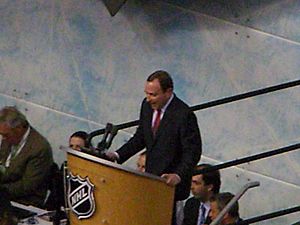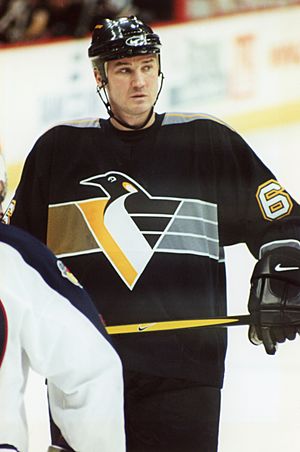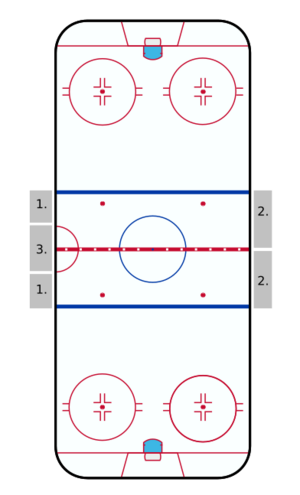History of the National Hockey League (1992–2017) facts for kids
The National Hockey League (NHL) went through an exciting and challenging time between 1992 and 2017. The league grew a lot, adding many new teams across the United States. It started with 22 teams and ended with 30!
However, there were also some tough periods. Players and team owners had disagreements about rules and money, which led to strikes in 1992, 1994–95, 2004–05, and 2012–13. The strike in 2004–05 was so big that the entire season was canceled. This was the first time a major sports league in North America had ever canceled a whole season because of a player dispute.
Nine new teams joined the NHL during this time: the San Jose Sharks, Ottawa Senators, Tampa Bay Lightning, Florida Panthers, Mighty Ducks of Anaheim, Nashville Predators, Atlanta Thrashers, Columbus Blue Jackets, and the Minnesota Wild. Some teams also moved to new cities. For example, the Minnesota North Stars became the Dallas Stars, and the Quebec Nordiques became the Colorado Avalanche.
In 1993, the Montreal Canadiens won their 24th championship, celebrating the Stanley Cup's 100th birthday. They are still the last Canadian team to win the Cup. The New York Rangers won in 1994, ending a 54-year wait! Other original teams like the Detroit Red Wings, Chicago Blackhawks, and Boston Bruins also ended long championship droughts. Meanwhile, teams in warmer, southern U.S. cities like the Dallas Stars, Tampa Bay Lightning, Carolina Hurricanes, Anaheim Ducks, and Los Angeles Kings won their first Stanley Cups.
Manon Rhéaume made history in 1992 when she played for the Lightning in a pre-season game. She was the first female player in the NHL! Wayne Gretzky became the NHL's all-time leading scorer in 1994. Mario Lemieux bravely battled cancer and still had an amazing career, scoring over 1,700 points and winning two championships. He even later became an owner of the Pittsburgh Penguins. This era also saw two new superstars, Sidney Crosby and Alexander Ovechkin, who brought new excitement to the Capitals-Penguins rivalry.
The Canada Cup tournament changed to the World Cup of Hockey in 1996. NHL players also started playing in the 1998 Winter Olympics. To make hockey popular around the world, the NHL played regular season games in Japan and Europe. The league also started playing outdoor games, like the Heritage Classic, Winter Classic, and Stadium Series.
Later in the 1990s, teams started playing more defensively, which meant fewer goals were scored. The league tried to change rules to make scoring easier. They started giving teams a point for losing in overtime in 1999. In 2005, they added the penalty shootout to make sure every game had a winner.
Contents
New Leadership and Player Rights
At the start of the 1990s, players felt uneasy with their union leader, Alan Eagleson. He was replaced by Bob Goodenow in 1991. Later, Eagleson was found guilty of stealing money from the players' association. He resigned from the Hockey Hall of Fame.
In 1992, the players went on their first strike, which lasted ten days. This strike helped players get more money for playoffs, more control over how their images were used, and better rights to become free agents. All the games that were canceled were rescheduled. This event also led the team owners to hire Gary Bettman as the league's first commissioner in 1993. His job was to make the game more popular in the U.S., solve player disputes, and modernize the league.
NHL Grows Bigger
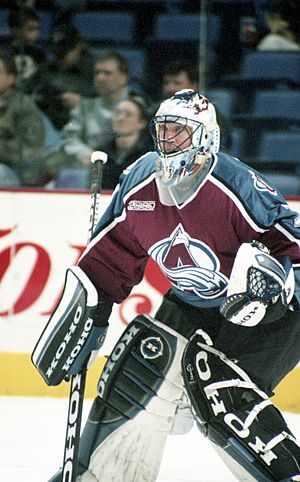
The Tampa Bay Lightning and Ottawa Senators joined the league in 1992. The Lightning made history when Manon Rhéaume became the first woman to play in an NHL game during a pre-season match in 1992. She also signed a professional contract with their farm team. A year later, the Mighty Ducks of Anaheim and Florida Panthers started playing. These teams were added to help the NHL get more TV attention in the southern U.S. The league hoped that big companies like Disney (who owned the Ducks) would help raise its profile.
The NHL's move south continued in 1993 when the Minnesota North Stars moved to Dallas, Texas, and became the Dallas Stars.
In 1993, the NHL celebrated the 100th anniversary of the Stanley Cup. The Montreal Canadiens won the Cup that year, beating Wayne Gretzky and the Los Angeles Kings. The Canadiens set an NHL record by winning ten overtime games in those playoffs!
The New York Rangers finally won the Stanley Cup in 1994 after 54 years. Many former Edmonton Oilers players were on that Rangers team, including Mark Messier, who became the first captain to win the Stanley Cup with two different teams. This win also meant that the first Russian players had their names engraved on the Stanley Cup.
Player Lockout in 1994–95
Just a few months later, the players were locked out by the team owners because they couldn't agree on a new contract. The 1994–95 NHL lockout lasted 104 days, and the season was shortened from 84 games to 48. Owners wanted to control how much player salaries grew and wanted a salary cap (a limit on how much teams could spend on players). The players suggested a "luxury tax" instead, where teams that spent too much would pay a penalty.
The two sides finally agreed to a deal just before the season was about to be canceled. The owners didn't get a full salary cap, but the players agreed to limits on rookie contracts and changes to how free agency worked.
This agreement wasn't enough to save two Canadian teams in smaller markets. The Winnipeg Jets moved to Phoenix, Arizona, in 1996, becoming the Phoenix Coyotes. A year before that, the Quebec Nordiques moved to Denver, Colorado, and became the Colorado Avalanche. To help other Canadian teams, the NHL created a plan to support them financially. The Hartford Whalers also moved in 1997, becoming the Carolina Hurricanes.
Less Scoring, More Defense
After the 1994–95 lockout, the NHL saw fewer goals being scored. In the 1980s, about 7.6 goals were scored per game. By 1998–99, that number dropped to 5.19. Some people thought this was because the league had expanded too much, spreading out the best players. Others blamed new defensive strategies, like the "neutral zone trap," which the New Jersey Devils used to win the Stanley Cup in 1995. This time was often called the "dead puck era." The Devils, Detroit Red Wings, and Colorado Avalanche were very strong during this period, winning eight championships in nine years.
The Canada Cup was replaced by the World Cup of Hockey in 1996. In the first tournament, the United States surprised everyone by beating Canada in the final. That same year, the Avalanche won their first Stanley Cup. A year later, the Detroit Red Wings won their first Stanley Cup since 1955, ending a 42-year wait.
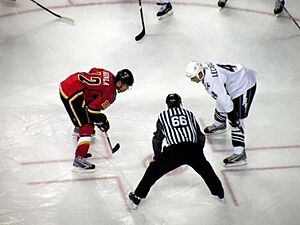
The NHL continued to grow, adding four more teams to reach a total of 30 clubs. The Nashville Predators joined in 1998, followed by the Atlanta Thrashers in 1999. The Minnesota Wild and Columbus Blue Jackets started playing in 2000.
On April 18, 1999, Wayne Gretzky played his last NHL game. He retired as the league's all-time leading scorer, holding 61 NHL records! His famous number, 99, was retired across the entire league. He was even inducted into the Hockey Hall of Fame right away, without the usual three-year wait.
For marketing reasons, the NHL allowed its players to compete in the Winter Olympics starting in 1998. At the Nagano Games, the Czech Republic won the tournament, led by amazing goaltender Dominik Hašek.
Teams from southern U.S. cities started appearing in the Stanley Cup Finals more often. The Dallas Stars won the Stanley Cup in 1999. The Tampa Bay Lightning won the Cup in 2004, beating the Calgary Flames. This win was seen as the end of an era dominated by the Devils, Avalanche, and Red Wings.
The Edmonton Oilers hosted the NHL's first regular season outdoor hockey game, the Heritage Classic, on November 22, 2003. It was played at Commonwealth Stadium in very cold weather, with over 57,000 fans watching!
Mario Lemieux's Incredible Career
When the Pittsburgh Penguins drafted Mario Lemieux in 1984, they hoped he would make their team better. He scored his first NHL goal on his first shot! On December 31, 1988, Lemieux did something no other player has ever done: he scored five goals in five different ways in one game (even strength, power play, short-handed, penalty shot, and empty net).
Mario Lemieux faced many injuries and illnesses throughout his career. He played only 26 games in 1990–91 due to back surgery, but he came back to lead the Penguins to their first Stanley Cup. He won another championship in 1992. In 1993, he was diagnosed with cancer. He went through 22 radiation treatments in 30 days. Just 12 hours after his last treatment, he returned to play and scored a goal!
Due to his injuries, Lemieux retired in 1997 and was immediately inducted into the Hockey Hall of Fame. But he wasn't done! Inspired by his son, he returned to the NHL in 2000–01. He even became the first player-owner in NHL history, buying the Penguins in 1999 to save them from going bankrupt. He continued to battle injuries and finally retired for good in 2006. Despite his challenges, Mario Lemieux is considered one of the greatest players ever.
The 2004–05 Lockout
By 2004, team owners said that player salaries were growing too fast and that the league was losing a lot of money. When the agreement between players and owners ended, Commissioner Gary Bettman announced another lockout for the 2004–05 season. Owners again wanted a salary cap, but players resisted.
On February 16, 2005, after many failed attempts to reach a deal, Bettman announced that the entire season was canceled. This was a first for any major North American sports league.
Eventually, the two sides agreed to a new deal. It included a strict salary cap, a pay cut for players, and new rules for free agency.
Since there were no standings from the canceled season, the NHL held a special lottery to decide the draft order for 2005. The Pittsburgh Penguins won and picked Sidney Crosby, a highly anticipated young player. Crosby and Alexander Ovechkin of the Washington Capitals (the first pick in 2004) were expected to become the new faces of the NHL. Ovechkin won the rookie of the year award in 2005–06, and Crosby's arrival helped the Penguins' attendance increase a lot.
The Shootout Era Begins
Crosby and Ovechkin Arrive
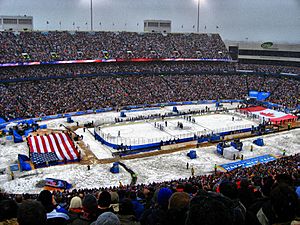
In the 2005–06 season, Ovechkin and Crosby began their amazing careers. They both quickly won major awards, showing they were superstars. The 2006 Stanley Cup Finals was special because it was the first time two teams that started in the World Hockey Association (a league that merged with the NHL) played for the Stanley Cup: the Oilers and the Hurricanes. The Hurricanes won. The next season, the Ducks won the Cup.
Penguins, Blackhawks, and Kings Dominate
The new salary cap in 2005 was supposed to make the league more balanced, but three teams still stood out. From 2008 to 2017, the Chicago Blackhawks, Los Angeles Kings, and Pittsburgh Penguins combined to win eight Stanley Cups!
The Pittsburgh Penguins lost the 2008 Stanley Cup to the Red Wings but got their revenge in 2009, winning their third Cup. Seven years later, in 2016, the Penguins won their fourth Cup, and then won again in 2017, becoming the first team to win back-to-back championships since 1998. Led by stars like Sidney Crosby, Evgeni Malkin, and Kris Letang, the Penguins became a powerhouse.
The Chicago Blackhawks also struggled in the early 2000s but turned things around after drafting Jonathan Toews in 2006 and Patrick Kane in 2007. This duo helped the Blackhawks end a 49-year Cup drought in 2010. They won two more Stanley Cups in 2013 and 2015.
The Los Angeles Kings also had a tough start but improved after hiring coach Daryl Sutter. They reached the Cup final in 2012 and won their first championship. They won another Stanley Cup in 2014.
The Boston Bruins were the only other team to reach the Stanley Cup Finals more than once during this time, winning in 2011 (their first since 1972) and losing in 2013.
Playing Outdoors
The success of the Heritage Classic led the NHL to schedule more outdoor games. The 2008 NHL Winter Classic was held on New Year's Day 2008 in Buffalo, with over 71,000 fans watching. The Winter Classic became an annual tradition, often played in front of huge crowds and watched by many on TV.
The Heritage Classic also continued, with games in Calgary, Vancouver, and Winnipeg. In the 2013–14 season, the NHL introduced the NHL Stadium Series, bringing outdoor hockey to warmer places like Los Angeles and Santa Clara, California. Overall, 31 NHL outdoor games have been played since 2008.
Global Hockey and Team Moves
To promote hockey worldwide, the league sent teams to Japan in 1998 to start the season. Since 2007, the NHL has sent teams to Europe to begin each season in cities like London, Prague, Stockholm, and Helsinki.
In 2010, Vancouver hosted the Winter Olympics, the first time an NHL city hosted the event since the league started participating. NHL players have continued to play in the Olympics, though their future participation has sometimes been uncertain.
The NHL also brought back the World Cup of Hockey tournament in 2016, twelve years after its last one.
Despite the league's growth, some teams still faced financial problems. The Phoenix Coyotes filed for bankruptcy in 2009. The league took control of the team to help it stay afloat until it was sold to new owners in 2013.
The Atlanta Thrashers also had financial troubles and were sold in 2011. The new owners moved the team to Winnipeg, Canada, where they became the second franchise known as the Winnipeg Jets. This was a big change from the league's earlier efforts to expand into the southern U.S.
The 2012–13 Lockout
The NHL had another lockout in 2012, which canceled the first 526 games of the season. After long negotiations, the NHL and the players' union reached a deal on January 6, 2013. The season finally started on January 19.
New Rules and Changes
To reduce tie games, the NHL changed its rules in 1999–2000. Teams tied after regulation time would get one point, and the team that won in overtime would get a second point. In 2005–06, ties were completely removed, and the shootout was introduced to decide all regular season games tied after overtime. The shootout has been popular with many fans, but some critics call it a "gimmick."
The shootout was one of several rule changes made in 2005 to increase scoring after the lockout. The "two-line pass" rule was removed, allowing teams to pass the puck further down the ice, hoping for more breakaways. Teams that commit an icing penalty are no longer allowed to change players before the next faceoff. Goaltenders are also now limited in where they can play the puck behind the net, only allowed within a special trapezoid area.
One of the most talked-about changes was the league's strict policy on "obstruction penalties." The NHL wanted to stop players from "clutching and grabbing" opponents, hoping to open up the game. This led to more penalties being called.
These changes initially led to a big increase in scoring in 2005–06, but scoring numbers soon dropped again in later seasons. Other rule changes since then include the "hybrid icing" rule, coach's challenges for certain plays, and three-on-three overtime periods.
Images for kids
-
The Washington Capitals and the Pittsburgh Penguins in Game Seven of the second round of the 2017 Stanley Cup playoffs.
-
Patrick Roy helped the Colorado Avalanche win the Stanley Cup in 1996.
-
Jarome Iginla and Vincent Lecavalier battling for the puck.
-
Ralph Wilson Stadium in Buffalo during the 2008 Winter Classic.


